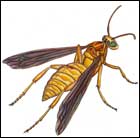Stinging Insects: Friend or Foe?
 According to the National Pest Management Association, stinging insects send more than 500,000 people to the emergency room each year. Stinging insects including yellowjackets, carpenter bees, hornets and wasps call a variety of locations in and around structures home including trees and bushes, building corners and overhangs, gutters, garbage dumpsters, and under patios and decks.
According to the National Pest Management Association, stinging insects send more than 500,000 people to the emergency room each year. Stinging insects including yellowjackets, carpenter bees, hornets and wasps call a variety of locations in and around structures home including trees and bushes, building corners and overhangs, gutters, garbage dumpsters, and under patios and decks.
It is also a known fact that certain species of stinging insects, like the honey and bumblebee, are very beneficial to our environment as they pollinate crops and flowers. But how do you know what stinging insect is a friend and which is a foe?
The Clark Man says proper identification of the species is the first step to determining if they are a threat or not. For example, the Africanized "killer" bees looks very similar to a regular honeybee that the only way to tell the two apart is by measuring their bodies. A dangerous stinging insect, the Africanized bee has been known to chase people for more than a quarter of a mile once they get excited and aggressive.
Other stinging insects that pose a threat to humans, especially in early fall when they are protecting nests they spent all summer constructing, are the bald-faced hornet, wasps and yellowjackets. The carpenter bee presents a two-headed threat as they will sting if disturbed but also will bore into wood decks and sidings to construct their nests and in the process weaken the structural integrity of the wood.
The Clark Man’s Three Tips for Avoiding Harmful Stinging Insects include:
1.) Identify It Correctly - There are many kinds of beneficial flies that closely resemble wasps, and there are many kinds of "solitary" wasps, such as sand wasps, which also look exactly the same as yellow jackets but that pose a much lower risk. The Clark Man will help make a proper identification before recommending a treatment option.
2.) Take Away the Source of the Infestation - Removing a stinging insect’s source of food, water and shelter is the first step toward preventing and eliminating these pests. Cleaning up food and grease spills in outdoor patios and cooking areas (especially around the grill), using tight fitting lids on garbage and recycling containers, and emptying them on a regular basis, and covering food in sealed containers.
3.) Use Exclusion Techniques - Seal exterior cracks and crevices to prevent stinging insects from entering a your home and building nests. Make sure window and door screens are in good repair.
The Clark Man recommends that if you have any doubt on whether or not a stinging insect or any pest is harmful, to please give us a call. We also strongly encourage homeowners not to try to move or destroy a stinging insect nests on their own – this could cause serious harm to you and your family – and leave the task to a trained professional.
If you have questions on stinging insects, call 800/WE-NEED-YOU or drop me an e-mail at clarkcares@clarkpest.com.
Until next time, I’m the Clark Man and thanks for helping me keep unwanted pests out of your home.


